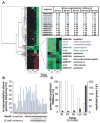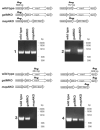Role of FNR and FNR-regulated, sugar fermentation genes in Neisseria meningitidis infection
- PMID: 16677307
- PMCID: PMC2258229
- DOI: 10.1111/j.1365-2958.2006.05163.x
Role of FNR and FNR-regulated, sugar fermentation genes in Neisseria meningitidis infection
Abstract
While it is generally accepted that anaerobic metabolism is required during infection, supporting experimental data have only been described in a limited number of studies. To provide additional evidence on the role of anaerobic metabolism in bacterial pathogens while invading mammalian hosts, we analysed the effect of the inactivation of FNR, the major regulatory protein involved in the adaptation to oxygen restrictive conditions, and of two of the FNR-regulated genes on the survival of Neisseria meningitidis serogroup B (MenB) in vivo. We found that fnr deletion resulted in more than 1 log reduction in the meningococcal capacity to proliferate both in infant rats and in mice. To identify which of the FNR-regulated genes were responsible for this attenuated phenotype, we defined the FNR regulon by combining DNA microarray analysis and FNR-DNA binding studies. Under oxygen-restricted conditions, FNR positively controlled the transcription of nine transcriptional units, the most upregulated of which were the two operons NMB0388-galM and mapA-pgmbeta implicated in sugar metabolism and fermentation. When galM and mapA were knocked out, the mutants were attenuated by 2 and 3 logs respectively. As the operons are controlled by FNR, from these data we conclude that MenB survival in the host anatomical sites where oxygen is limiting is supported by sugar fermentation.
Figures



References
-
- Arai H, Mizutani M, Igarashi Y. Transcriptional regulation of the nos genes for nitrous oxide reductase in Pseudomonas aeruginosa. Microbiol. 2003;149:29–36. - PubMed
Publication types
MeSH terms
Substances
Grants and funding
LinkOut - more resources
Full Text Sources
Other Literature Sources
Molecular Biology Databases
Research Materials

